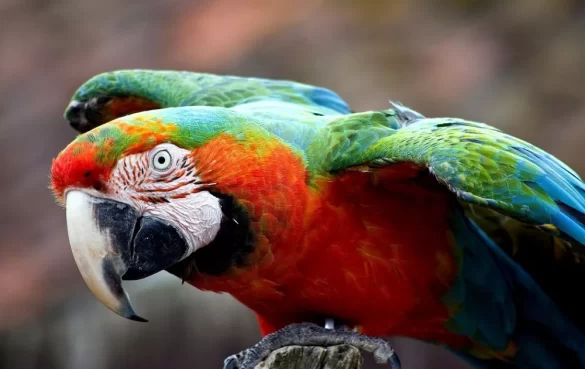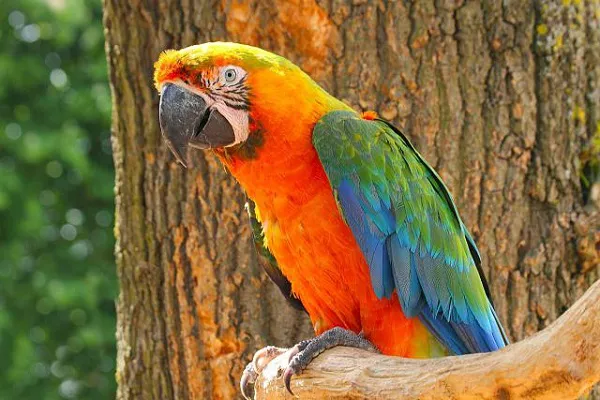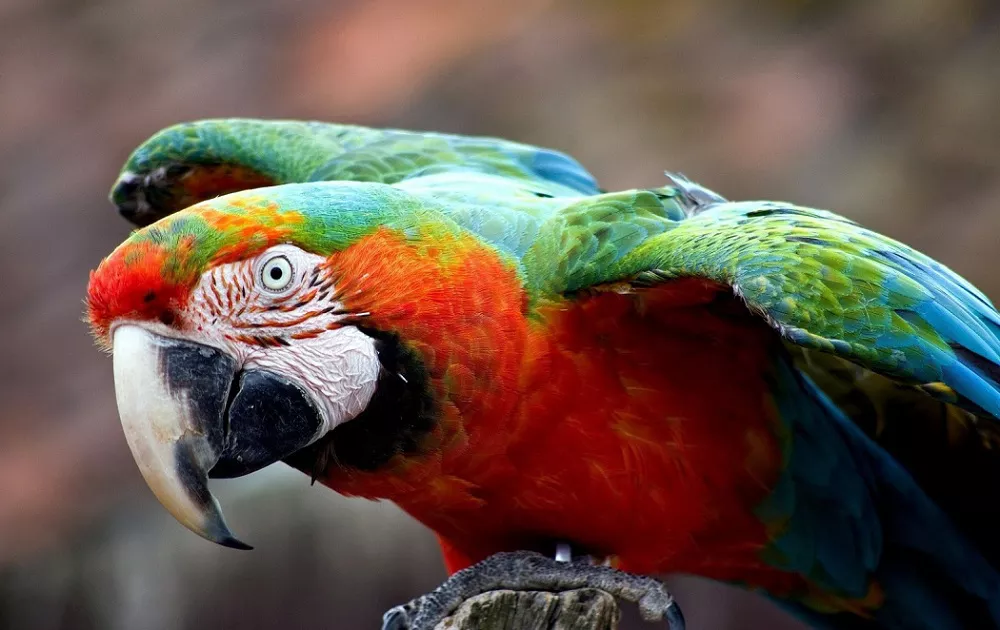Macaws are among the world’s most captivating parrots—famous for their intelligence, long lifespan, and rainbow-colored feathers. Among them, two hybrids stand out: the Catalina Macaw and the Harlequin Macaw.
At first glance, these exotic parrots might seem similar. Both are colorful hybrids bred from pure macaw species. Both are intelligent, affectionate, and strikingly beautiful. Yet, their lineage, personality, coloration, and care requirements differ in important ways.
This article offers an in-depth comparison between the Catalina Macaw and Harlequin Macaw, helping you understand their origins, personalities, appearance, lifespan, and which one might be the best companion for your lifestyle.
What Are Hybrid Macaws?
Hybrid macaws are crossbreeds between two different macaw species, created in captivity. Breeders combine distinct traits—like color, temperament, and intelligence—from each parent to produce visually stunning, highly social parrots.
Because they’re hybrids, no two individuals look or behave exactly alike. Even among Catalinas or Harlequins, plumage shades and personality nuances can vary.
Both Catalina and Harlequin macaws are first-generation hybrids, meaning they are bred from two pure species.
Catalina Macaw: The Fiery Hybrid
Origin
The Catalina Macaw results from crossing a Scarlet Macaw (Ara macao) and a Blue and Gold Macaw (Ara ararauna). Usually, the Scarlet is the mother, and the Blue and Gold is the father.
This combination yields a parrot as radiant as a tropical sunset—full of fiery reds, oranges, and blues.
Appearance
Catalina macaws are among the most colorful hybrids. Their plumage typically includes:
- Bright red head and chest from the Scarlet parent.
- Orange to yellow mid-body feathers fading into blue and green wings.
- Long tapering tail with red, blue, and gold hues.
- Strong, black beak and expressive white facial skin patches.
Each Catalina’s color pattern is unique, depending on genetic dominance.
Size and Weight
- Length: 33–36 inches (84–91 cm)
- Weight: 2–3 pounds (0.9–1.4 kg)
Temperament and Personality
Catalina macaws are bold, active, and intelligent. They combine the Scarlet’s fiery temperament with the Blue and Gold’s social charm.
They’re playful, curious, and affectionate—but also strong-willed. Without daily interaction and positive reinforcement, they can become demanding or stubborn.
Traits:
- Energetic and playful
- Intelligent and talkative
- Affectionate but assertive
- Requires consistent socialization
Talking Ability
Catalina macaws are excellent talkers. They can mimic human speech, sounds, and even laughter, often learning 20+ words. However, their voices are loud and piercing—best suited for spacious homes.
Lifespan
With proper diet and care, Catalina macaws live 50–70 years, sometimes longer.
Care Requirements
They require:
- Large cage or aviary (minimum 4 ft wide, 6 ft high)
- At least 3–4 hours of daily social time
- Foraging and chew toys for mental stimulation
- Balanced diet of pellets, fruits, vegetables, and nuts
Catalinas thrive in homes that can meet their high energy and social needs.
Harlequin Macaw: The Gentle Clown
Origin
The Harlequin Macaw is a hybrid between the Green-winged Macaw (Ara chloropterus) and the Blue and Gold Macaw (Ara ararauna).
“Harlequin” means “clown,” referring to their brilliant color mix and playful, gentle personality.
Appearance
The Harlequin’s feathers often include:
- Green forehead blending into turquoise-blue wings.
- Golden-orange chest and belly.
- Red and blue tail feathers.
- White facial skin lined with small red feathers (from the Green-winged parent).
Each bird’s hue intensity varies depending on which parent’s genes dominate.
Size and Weight
- Length: 34–37 inches (86–94 cm)
- Weight: 2.5–3.5 pounds (1.1–1.6 kg)
Temperament and Personality
The Harlequin Macaw is often called the “gentle giant” of hybrid macaws.
They blend the Green-winged’s calm, affectionate nature with the Blue and Gold’s playful charm. These birds are loving, social, and emotionally intelligent, making them great family pets.
Traits:
- Gentle and affectionate
- Intelligent and trainable
- Playful but patient
- Loyal to their caretakers
Talking Ability
Harlequin macaws can learn to speak and mimic various sounds, though they tend to be less noisy than Catalinas. Their tone is deeper and more soothing.
Lifespan
With proper care, Harlequin macaws can live 50–80 years or more.
Care Requirements
Like Catalinas, Harlequins need:
- Spacious enclosures and daily flight time
- Frequent interaction and enrichment activities
- Healthy diet of pellets, fruits, veggies, and nuts
- Regular grooming and social bonding
Their gentle demeanor makes them easier for families and beginner macaw owners—provided they have time for daily care.
Catalina Macaw vs Harlequin Macaw
| Feature | Catalina Macaw | Harlequin Macaw |
|---|---|---|
| Parent Species | Scarlet × Blue and Gold | Green-winged × Blue and Gold |
| Temperament | Energetic, assertive, social | Calm, affectionate, loyal |
| Coloration | Fiery reds, oranges, blues | Green, gold, turquoise, red |
| Size | Slightly smaller | Larger and broader |
| Personality Type | Bold and talkative | Gentle and balanced |
| Talking Ability | Excellent speaker, loud | Good mimic, softer tone |
| Best For | Experienced owners | Families and calm homes |
| Lifespan | 50–70 years | 50–80 years |
| Noise Level | High | Moderate to high |
| Social Needs | Extremely high | Very high but adaptable |
Which Macaw Is Right for You?
Choosing between the Catalina and Harlequin macaw depends on your experience, patience, and environment.
1. Choose the Catalina Macaw if:
- You’ve owned large parrots before.
- You enjoy energetic, talkative birds.
- You can handle loud calls and playful mischief.
- You’re looking for a colorful, extroverted companion.
2. Choose the Harlequin Macaw if:
- You prefer a calmer, affectionate parrot.
- You’re new to large macaw ownership.
- You have time for bonding but want a steadier temperament.
- You live in a family setting or quieter household.
Both macaws require commitment, enrichment, and companionship, but the Harlequin is often the more forgiving hybrid for first-time large parrot owners.
Health, Diet, and Lifespan
Both macaws are long-lived and hardy but susceptible to:
- Aspergillosis (fungal infection)
- Psittacosis (bacterial infection)
- Nutritional deficiencies from poor diet
- Feather plucking from stress or boredom
Feed them:
- Pellets (60–70%)
- Fresh fruits and vegetables (20–30%)
- Nuts and seeds (10%) as treats
Avoid avocado, chocolate, caffeine, and alcohol, which are toxic to parrots.
Training and Enrichment
Catalina and Harlequin macaws excel at learning commands, tricks, and speech when trained consistently.
Training Tips:
- Use positive reinforcement with treats and praise.
- Keep training sessions short (5–10 minutes).
- Provide daily out-of-cage time for exercise.
- Rotate toys to prevent boredom.
- Establish boundaries early to prevent dominance issues.
Both species need mental challenges—like puzzle toys or food-foraging games—to stay happy.
Cost and Availability
Hybrid macaws are prized among parrot enthusiasts. Prices vary by color, breeder, and lineage.
| Type | Average Price (USD) |
|---|---|
| Catalina Macaw | $3,000 – $5,000 |
| Harlequin Macaw | $3,500 – $6,000 |
Always choose ethical breeders who raise hand-fed, socialized chicks and provide health documentation. Avoid impulse purchases—these birds are a 50-year commitment.
Final Thoughts
Both the Catalina Macaw and Harlequin Macaw are extraordinary parrots that combine beauty, intelligence, and emotional depth.
- The Catalina is lively, colorful, and charismatic—perfect for active, experienced owners.
- The Harlequin is gentle, loving, and balanced—ideal for families or first-time macaw enthusiasts.
Regardless of which you choose, both require time, attention, and long-term dedication. In return, you’ll gain a loyal, vibrant companion that fills your home with laughter and color for decades.
Frequently Asked Questions (FAQ)
1. Are Catalina and Harlequin macaws good pets?
Yes. Both are intelligent, affectionate, and trainable. However, they require daily attention and a large, stimulating environment.
2. Which macaw talks better — Catalina or Harlequin?
Catalina macaws are generally more talkative and expressive. Harlequins can also speak well but tend to be quieter and more relaxed.
3. Do Catalina and Harlequin macaws get along with other birds?
They can, but only with careful supervision. Both are social but can become territorial, especially during breeding season.
4. Which macaw is easier to train?
The Harlequin Macaw is slightly easier due to its calm temperament, while the Catalina’s energy requires more structured training.
5. How long do these hybrid macaws live?
Both species can live 50–80 years with proper nutrition, exercise, and veterinary care.




 Facebook
Facebook  Instagram
Instagram  Youtube
Youtube 